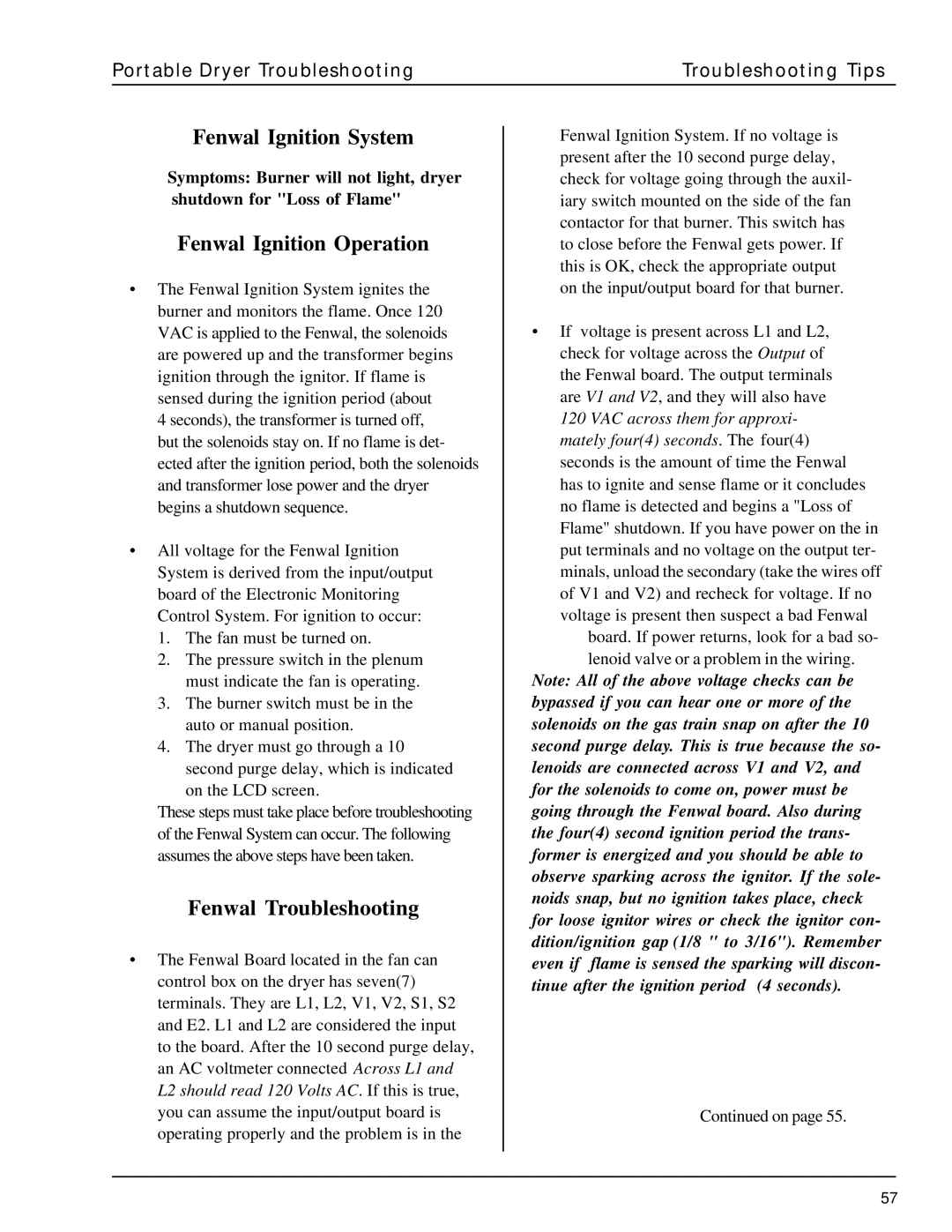
Portable Dryer Troubleshooting | Troubleshooting Tips |
Fenwal Ignition System
Symptoms: Burner will not light, dryer shutdown for "Loss of Flame"
Fenwal Ignition Operation
•The Fenwal Ignition System ignites the FenwalburnerIgnitionand monitorsOperationthe flame. Once 120
VAC is applied to the Fenwal, the solenoids are powered up and the transformer begins ignition through the ignitor. If flame is sensed during the ignition period (about
4seconds), the transformer is turned off, but the solenoids stay on. If no flame is det- ected after the ignition period, both the solenoids and transformer lose power and the dryer begins a shutdown sequence.
•All voltage for the Fenwal Ignition System is derived from the input/output board of the Electronic Monitoring Control System. For ignition to occur:
1.The fan must be turned on.
2.The pressure switch in the plenum must indicate the fan is operating.
3.The burner switch must be in the auto or manual position.
4.The dryer must go through a 10 second purge delay, which is indicated
ing on the LCD screen.
These steps must take place before troubleshooting of the Fenwal System can occur. The following assumes the above steps have been taken.
Fenwal Troubleshooting
•The Fenwal Board located in the fan can control box on the dryer has seven(7) terminals. They are L1, L2, V1, V2, S1, S2 and E2. L1 and L2 are considered the input to the board. After the 10 second purge delay, an AC voltmeter connected Across L1 and
L2 should read 120 Volts AC. If this is true, you can assume the input/output board is operating properly and the problem is in the
Fenwal Ignition System. If no voltage is present after the 10 second purge delay, check for voltage going through the auxil- iary switch mounted on the side of the fan contactor for that burner. This switch has to close before the Fenwal gets power. If this is OK, check the appropriate output on the input/output board for that burner.
•If voltage is present across L1 and L2, check for voltage across the Output of the Fenwal board. The output terminals are V1 and V2, and they will also have 120 VAC across them for approxi- mately four(4) seconds. The four(4) seconds is the amount of time the Fenwal has to ignite and sense flame or it concludes no flame is detected and begins a "Loss of Flame" shutdown. If you have power on the in put terminals and no voltage on the output ter- minals, unload the secondary (take the wires off of V1 and V2) and recheck for voltage. If no voltage is present then suspect a bad Fenwal
board. If power returns, look for a bad so-
lenoid valve or a problem in the wiring.
Note: All of the above voltage checks can be bypassed if you can hear one or more of the solenoids on the gas train snap on after the 10 second purge delay. This is true because the so- lenoids are connected across V1 and V2, and for the solenoids to come on, power must be going through the Fenwal board. Also during the four(4) second ignition period the trans- former is energized and you should be able to observe sparking across the ignitor. If the sole- noids snap, but no ignition takes place, check for loose ignitor wires or check the ignitor con- dition/ignition gap (1/8 " to 3/16"). Remember even if flame is sensed the sparking will discon- tinue after the ignition period (4 seconds).
Continued on page 55.
57
